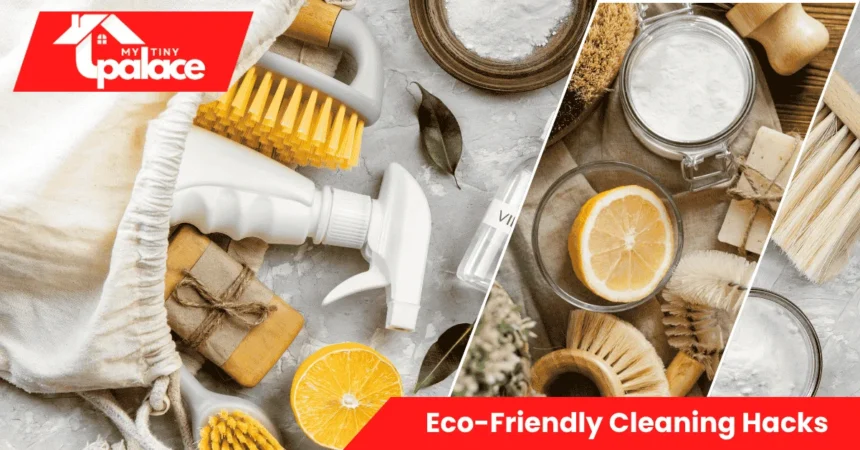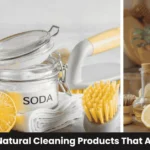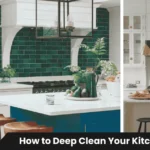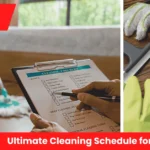A typical household cleaner contains dozens of synthetic chemicals, many linked to respiratory issues and skin irritation. The good news? You probably already own the three ingredients that clean 90% of home surfaces safely: white vinegar, baking soda, and plain dish soap.
- Quick summary
- Eco-Friendly Cleaning Hacks
- Why green cleaning matters for your home and health
- Core solutions: natural ingredients & safe tools
- How to choose the right hack for the mess
- Step-by-step: make and use one reliable hack (all-purpose spray)
- Costs, time, effectiveness — compact comparison table
- Pros & cons — who should use eco hacks (and when not to)
- Quick summary + CTA (what to try this week)
Quick summary
You can switch to green cleaning without sacrificing effectiveness or spending more money. Simple swaps—like homemade all-purpose spray, microfiber cloths, and baking soda scrubs—handle everyday messes while cutting plastic waste and improving indoor air quality. Most eco-friendly cleaning hacks cost pennies per use and work just as well as conventional products for routine maintenance.
Eco-Friendly Cleaning Hacks
Eco-friendly cleaning hacks are low-toxicity methods that replace harsh commercial cleaners with natural ingredients or reusable tools. These approaches minimize chemical exposure, reduce single-use plastic waste, and often cost less than buying bottled products every month. The core trio—white vinegar (acidic), baking soda (mildly abrasive and alkaline), and lemon juice (acidic with natural oils)—handles most daily cleaning tasks when used correctly.
These hacks work best for regular maintenance: wiping counters, cleaning glass, freshening drains, and spot-treating stains. They’re less effective on serious mold infestations, baked-on grease in commercial kitchens, or heavily soiled grout that needs professional restoration. Think of green cleaning as preventive care rather than emergency repair.
Important safety notes: vinegar and other acids can damage natural stone like marble and granite by etching the surface. Always test DIY cleaners on hidden spots first. If you have pets, avoid essential oils in homemade cleaners—many oils are toxic to cats and dogs, even in small amounts. People with asthma or allergies should ensure good ventilation when cleaning with any product, natural or not.
Why green cleaning matters for your home and health
Indoor air quality directly affects your daily health. Conventional cleaners release volatile organic compounds (VOCs) that linger in the air for hours after use. These fumes can trigger headaches, worsen asthma symptoms, and cause eye and throat irritation. Switching to plant-based or simple ingredient cleaners dramatically reduces these airborne chemicals, especially important in homes with limited ventilation or in colder months when windows stay closed.
Chemical exposure adds up over time. Your skin absorbs ingredients from cleaning products, and residue stays on surfaces long after you wipe them down. Children and pets spend more time on floors and put their hands (or paws) in their mouths, increasing their exposure risk. Non-toxic alternatives break this cycle without requiring you to live with dirty surfaces.
Cost savings surprise most people. A gallon of white vinegar costs about $3 and makes 16 spray bottles of all-purpose cleaner. A box of baking soda runs $1 and handles dozens of scrubbing sessions. Even factoring in reusable spray bottles and microfiber cloths, most households spend 60–70% less on cleaning supplies after switching to green methods. That’s $200–$300 in annual savings for an average family.
Waste reduction matters too. Americans throw away roughly 1.5 billion plastic spray bottles each year. Switching to refillable bottles and concentrated solutions dramatically cuts this number. Microfiber cloths last for years with proper care, replacing thousands of disposable paper towels and wipes.
The realistic limits: green cleaning works brilliantly for maintenance, but struggles with extreme situations. Black mold requires specialized treatment and often professional remediation. Heavy grease buildup in rental ovens may need stronger degreasers. Badly stained grout might need oxygen bleach or steam cleaning. Know when to escalate beyond DIY methods—forcing a natural solution on a serious problem wastes time and can make damage worse.
Core solutions: natural ingredients & safe tools
Acidic cleaners like white vinegar and lemon juice cut through mineral deposits, soap scum, and light grease. Vinegar contains acetic acid that dissolves calcium buildup on faucets and showerheads. Lemon juice adds natural oils that help break down sticky residue. Both work well on glass, tile, stainless steel, and sealed wood. Never use them on natural stone, cast iron, or unsealed grout—the acid etches and damages these surfaces.
Alkaline cleaners like baking soda neutralize acids and provide gentle abrasion. Baking soda absorbs odors, scours without scratching most surfaces, and boosts other cleaning solutions when combined properly. It handles stovetops, sinks, bathtubs, and refrigerator interiors safely. Mix it into a paste with water for tougher scrubbing jobs.
Castile soap serves as your main surfactant—the ingredient that actually lifts dirt and grease so water can rinse it away. This plant-based soap works in all-purpose sprays, floor cleaners, and hand soap dilutions. A little goes a long way; too much creates sticky residue that’s hard to rinse.
Enzymatic alternatives tackle organic matter that other cleaners miss. Enzyme-based drain cleaners break down hair, food particles, and soap buildup without the harsh chemicals in conventional drain openers. They work slowly—usually overnight—but safely clear most clogs caused by organic material. They won’t dissolve plastic toys or clear mineral blockages, so know your drain problem before choosing this option.
Reusable tools amplify your cleaning effectiveness. Microfiber cloths trap dust and bacteria in their tiny fibers rather than just pushing particles around. They clean with plain water for most tasks, eliminating the need for chemical sprays on many surfaces. Quality microfiber lasts 500–1,000 washes when cared for properly—no fabric softener, moderate heat for drying.
Refillable spray bottles let you mix fresh cleaner as needed rather than storing large batches that lose potency. Choose dark-colored bottles for solutions containing lemon or other light-sensitive ingredients. Label everything clearly with contents and mixing date to avoid confusion.
How to choose the right hack for the mess
Surface type determines your cleaning approach. Glass and mirrors need streak-free solutions—diluted vinegar works perfectly. Wood requires pH-neutral cleaners that won’t strip the finish. Stainless steel shows water spots unless you dry immediately or add a tiny amount of oil after cleaning. Delicate surfaces like marble need specialized products; don’t experiment with acids.
Stain type matters as much as surface type. Protein-based stains (blood, egg, dairy) need cold water and enzymatic action. Tannin stains (coffee, tea, wine) respond to mild acids. Grease needs surfactants and sometimes alkaline boosters. Oil-based stains often require rubbing alcohol as a solvent. Using the wrong approach can set stains permanently.
Time availability shapes your cleaning strategy. Quick daily wipes with a damp microfiber cloth prevent buildup that requires heavy scrubbing later. Deep cleaning takes longer but happens less frequently. Match your hack to your schedule—don’t start a project that needs overnight dwell time when you need the space in an hour.
Sensitivity considerations protect your household. Homes with pets should skip essential oils entirely and ensure all residues rinse completely. Children crawling on floors need extra-thorough rinsing to remove any cleaner traces. People with fragrance sensitivities should stick to unscented options like plain vinegar and baking soda, even though they smell during use.
A simple decision rule: start with physical cleaning (dust, sweep, wipe with plain water), then try the mildest DIY solution appropriate for your surface, and only escalate to commercial eco-products if the gentler approach fails. This sequence minimizes chemical use while still getting surfaces clean.
Renters need reversible solutions that don’t risk security deposits. Stick to cleaning methods rather than restoration projects. Get landlord approval before using anything on grout or trying to remove mysterious stains—you could be held responsible for damage, even if you were trying to improve the space. Focus on maintaining what’s already clean rather than fixing years of neglect.
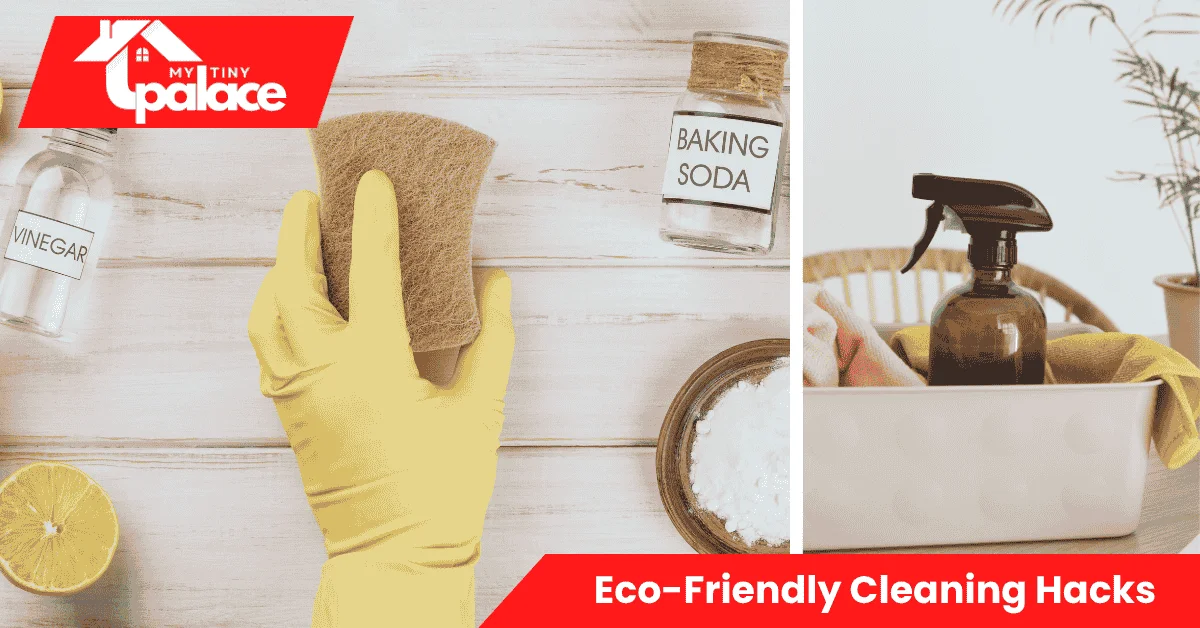
Step-by-step: make and use one reliable hack (all-purpose spray)
This basic all-purpose spray handles countertops, appliances, bathroom fixtures, and sealed surfaces throughout your home. It costs about $0.20 per 16-ounce bottle and stays effective for 2–3 weeks.
Materials & tools checklist
Ingredients: 1 cup white vinegar (5% acidity), 1 cup water (filtered if your tap water is very hard), 1 teaspoon liquid castile soap, optional 10 drops lemon essential oil, only if no pets (omit for pet-safe version).
Tools: 16-ounce spray bottle (preferably glass or HDPE plastic #2), small funnel, measuring cup, label, and marker.
Total cost: About $0.20 per bottle once you own the supplies.
Quick step sequence
Step 1: Prepare your bottle. Wash and rinse your spray bottle thoroughly if it previously held commercial cleaner. Residual chemicals can react unpredictably with natural ingredients. Dry completely or use immediately after rinsing—don’t let water sit in the bottle growing bacteria.
Step 2: Mix the solution. Add 1 cup of water first, then 1 cup of white vinegar. This order prevents excessive foaming. Add 1 teaspoon castile soap last—too much soap leaves sticky residue, so measure carefully. If using essential oil for scent, add it now. Swirl gently to combine; don’t shake hard or you’ll create foam that takes time to settle.
Step 3: Label and test. Write “All-Purpose Spray” and the date on your bottle. Test on a hidden spot of any new surface before spraying visibly. Wait 5 minutes and check for discoloration, cloudiness, or damage. If the surface looks fine, proceed to regular use.
Step 4: Apply correctly. Spray directly onto non-porous surfaces like countertops, sinks, and tile. For wood or delicate surfaces, spray your cloth instead of the surface to avoid over-wetting. Let the solution sit for 30–60 seconds on dirty spots—this dwell time allows the acid to break down grime and the soap to lift oils.
Step 5: Wipe and finish. Use a clean microfiber cloth or cotton rag to wipe surfaces thoroughly. The vinegar smell dissipates as it dries, usually within 5–10 minutes. For streak-free results on glass, buff dry with a second clean cloth immediately after wiping.
Storage and lifespan. Store your spray at room temperature away from direct sunlight. The solution stays effective for 2–3 weeks; after that, the castile soap can separate, and the vinegar weakens slightly. Make small batches rather than bulk quantities. Dispose of old solution by pouring it down the drain—it won’t harm septic systems or pipes.
Safety notes: Keep spray bottles out of children’s reach, even though ingredients are non-toxic—concentrated vinegar stings if sprayed in the eyes. Never mix vinegar with hydrogen peroxide in the same container—use them separately, rinsing between applications. Don’t use this spray on natural stone, cast iron cookware, or anything unsealed. If a surface looks cloudy after application, you’re on the wrong material; rinse immediately with plain water.
Costs, time, effectiveness — compact comparison table
| Hack | Cost Per Use | Time | Best For | Effectiveness Note |
|---|---|---|---|---|
| All-purpose vinegar spray | $0.20 per bottle | 2 min to mix | Counters, glass, tile, fixtures | Great for maintenance; weak on heavy grease |
| Baking soda scrub | $0.05 per use | 5 min scrub time | Sinks, tubs, stovetops | Excellent abrasive; needs elbow grease |
| Lemon degreaser (lemon + salt) | $0.30 per use | 10 min with dwell | Cutting boards, light grease | Works well; stains some plastics |
| Microfiber + water | $0.00 per use (after initial $8 cloth) | 3 min per room | Dusting, light spills, windows | Surprisingly effective; reduces chemical use by 80% |
| Enzyme drain cleaner (DIY or commercial) | $0.50–$1.00 per treatment | Overnight dwell | Slow drains, odor prevention | Slow but safe; won’t clear hair clogs alone |
Budget tips: Buy vinegar and baking soda in bulk—warehouse stores sell gallon jugs and large boxes at half the per-unit cost. Invest in 4–6 quality microfiber cloths (about $2 each) and you’ll eliminate paper towel purchases for cleaning. Refill spray bottles save $3–$5 per bottle compared to buying pre-made eco-cleaners.
Many eco-friendly brands now sell concentrated refills that you mix at home. These reduce plastic waste and cost less per use than ready-to-spray bottles. Compare concentrates to your homemade versions—sometimes the convenience justifies a slight price increase, especially for specialized formulas like bathroom cleaners.
Pros & cons — who should use eco hacks (and when not to)
Green cleaning hacks work beautifully for people committed to regular maintenance. If you wipe counters daily, clean bathrooms weekly, and address spills promptly, natural methods keep everything fresh without needing harsh chemicals. These approaches also suit households focused on reducing waste, chemical sensitivity, or environmental impact.
Skip DIY cleaners when facing serious problems that need specialized solutions. Black mold requires proper antimicrobial treatment and often professional assessment to find the moisture source. Commercial kitchens with heavy grease buildup need industrial degreasers—natural options simply can’t cut through that level of soil. Badly neglected homes might need conventional cleaners for initial deep cleaning before switching to green maintenance.
Certain surfaces demand specific products regardless of your eco preferences. Natural stone requires pH-neutral cleaners; acids cause permanent etching. Some hardwood floor finishes void warranties if you use vinegar. Always check manufacturer recommendations before experimenting with DIY solutions on expensive surfaces.
Call a professional if you see mold spreading rapidly, smell sewage backing up through drains, or notice water damage signs like soft spots or persistent dampness. These situations indicate underlying problems that cleaning can’t fix. Trying to clean away symptoms wastes time and allows structural damage to worsen.
One clear rule: if a cleaning challenge involves potential health hazards (mold, sewage, strong chemical spills) or expensive surface damage risks (marble etching, wood finish stripping), get expert advice before proceeding. The cost of professional help usually runs less than fixing DIY mistakes.
Quick summary + CTA (what to try this week)
Starting with eco-friendly cleaning hacks doesn’t require transforming your entire routine overnight. Three simple changes deliver immediate results: mix one batch of all-purpose vinegar spray for your kitchen and bathroom, replace paper towels with two microfiber cloths, and try a baking soda scrub on your sink. These three swaps cost under $15 total and handle most daily cleaning tasks.
Pick one room this weekend and commit to cleaning it entirely with green methods. You’ll quickly learn which hacks work best for your specific surfaces and messes. Most people discover that natural solutions handle 80–90% of their cleaning needs with no compromise on results.
Make your first batch of all-purpose spray today. Measure the ingredients, label your bottle, and use it for one week. Compare how your home looks, how the air smells, and how your hands feel after cleaning. That direct experience usually converts skeptics into regular users of eco-friendly cleaning methods.






